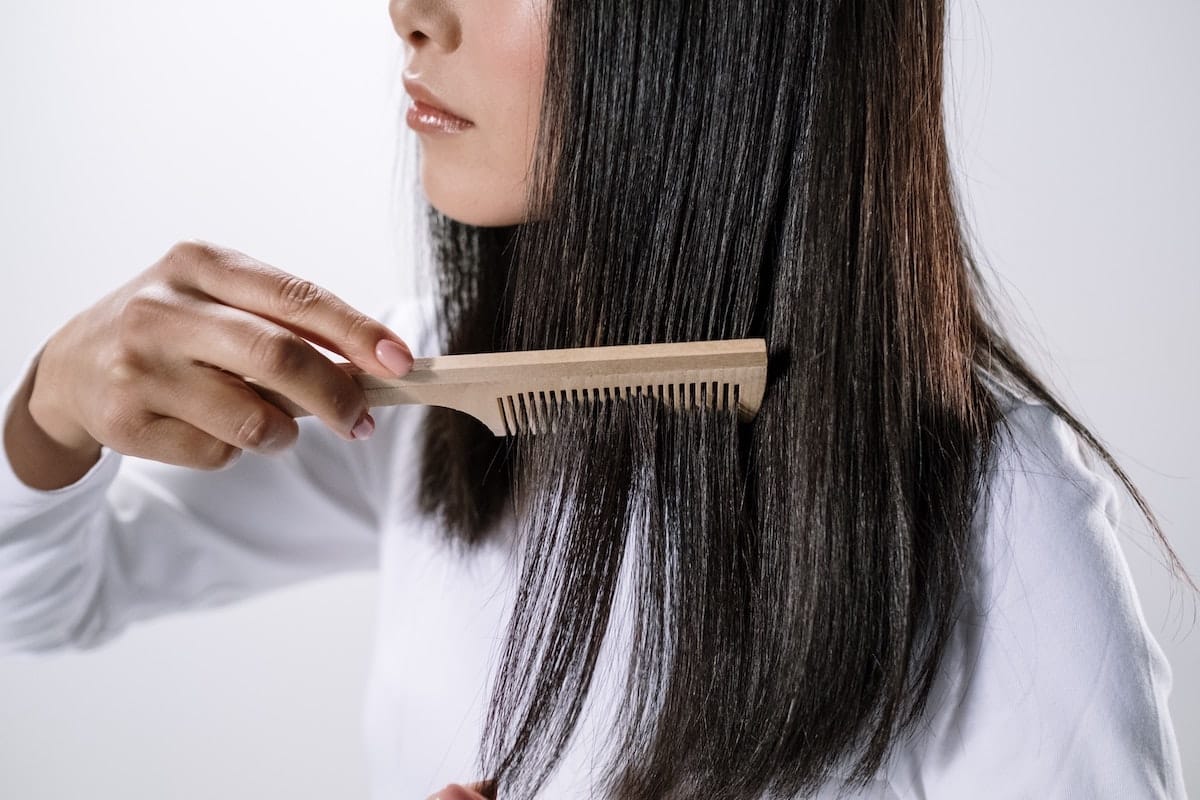Things to remember
Only 10% of female hair loss is not linked to an androgenetic problem*.
In these 10% cases, a variety of causes may be at the origin of the hair loss :
- Abundant and temporary abundant and temporary (telogen effluvium) hair loss, such as after childbirth.
- Long-lasting hair loss if left untreated, such as that caused by iron deficiency or thyroid disorders.
- Massive hair loss : alopecia areata, chemotherapy.
- Localised hair loss due to traction.
* For a problem linked to an androgen hormone disorder and accounting for 90 % of falls (cf. androgenetic hair loss in women).
TELOGEN EFFLUVIUM: ABUNDANT HAIR LOSS
Telogen effluvium is a medical term that means the rapid removal of too much hair that is in the telogen phase (i.e. already dead). In plain English, this corresponds to a large hair loss, this is caused by a temporary physiological change. This change can have repercussions on the renewal of the hair's life cycle.
The main characteristics of telogen effluvium are as follows:
- Your entire scalp is affected. Telogen effluvium differs from androgenetic hair loss, which is localised in both men and women.
- Time-limited: generally 3 months, maximum 4.
- Perceptible 2 to 4 months after the triggering event.
- Abundant hair loss, hair may come in handfuls.
- Reversible in most cases.
- With immediate regrowth.
Be careful, no more than 3 or 4 months!
Telogen effluvium hair loss is temporary. If your hair loss lasts longer than 3 or 4 months, or if you notice that your new growth is weaker, then another cause is at the root of the problem. Hair loss due to effluvium can conceal another cause. For example, hair loss that starts after childbirth and continues well beyond 12 weeks, without producing immediate regrowth, is likely to be a tell-tale sign of androgenetic alopecia.
There are many causes of telogenous effluvium:
THE MOST COMMON IN WOMEN
- Giving birth as well as miscarriage or abortion.
- But also: stopping an oestroprogestogenic contraceptive. Discontinuing a contraceptive of this kind sometimes causes telogen effluvium, similar to the so-called post-partum effluvium. This is a logical phenomenon: the addition of synthetic oestrogens can stimulate hair vitality and prolong hair cycles for the duration of the contraceptive treatment. Stopping the treatment causes more hair to fall out. This hair loss is diffuse and reversible: after a few weeks, everything returns to normal if the scalp is not particularly sensitive to androgens.
IN WOMEN AND MEN
- Seasonal changes: at spring and above all in autumn,
- Major surgery with prolonged general anaesthetic,
- A high, prolonged fever of over 39°5 C due to an infectious disease (influenza, typhoid fever, scarlet fever...),
- A so-called "local" infection (dental abscess, sore throat, etc.),
- A violent emotional shock: death of a loved one, serious accident, divorce, etc.
DIFFUSE HAIR LOSS
To recognise your symptoms:
- The entire head is affected.
- It occurs 2 to 4 months after the onset of the triggering factor.
- It continues for as long as this factor is active.
- It is totally or partially reversible, depending on the nature of the influencing factor.
- It frequently leads to thinning hair.
The most frequently cited causes are :
- A state of permanent stress,
- A thyroid problem: hypothyroidism or hyperthyroidism
- An iron deficiency,
- Diabetes,
- Anorexia or a strict and unbalanced diet ,
- Taking certain medicines,
Cumulative effect
Any new negative influence can exacerbate existing hair loss. Negative factors can 'pile up' and produce a cumulative effect, especially if you have an androgenetic background. A deficiency in iron or vitamin D, for example, is often associated with hereditary hair loss and can accelerate hair loss and transform it into full-blown hair loss. When diagnosing hair loss, the hair specialist must distinguish between triggering factors and aggravating factors, so as to better adapt the treatment of your hair's vital functions.
TRACTION HAIR LOSS
Traction is caused by catogan hairstyles or extensions. It is most frequently seen on Afro scalps, due to small braids that are too tight at the base, or hair extensions that are too heavy. This type of hair loss 'pulls' the roots of your hair out of their hair follicles. In the areas where the pull is exerted, your new growth becomes thinner and thinner. Minor irritation and inflammation of the scalp may also occur. Your hair becomes progressively thinner, with the formation of hairless areas when the renewal cycles are exhausted.


La hair loss due to pulling out can be placed in the same category. In medical terms, it is known as "trichotillomania". The person concerned has a habit of regularly pulling out their hair. In children, this is usually a simple tic, such as thumb-sucking. In adults, the mania may reflect a psychological disorder.
MASSIVE HAIR LOSS
Alopecia areata
It is distinguished from other hair loss by its sudden and unpredictable nature. The cause of alopecia areata is still a mystery. It may be an autoimmune disease. But this hypothesis is still controversial...
Chemotherapy
The anti-cancer agents abruptly block the production of keratin in the hair during the growth phase. This is why this type of hair loss is the only one known as "anagen effluvium".
FALSE HAIR LOSS
Poorly executed or too frequently repeated cosmetic manipulations can sometimes cause serious damage. Hair can become brittle and fall out at all lengths, including at the level of the scalp, which reduces the overall volume of the hair. In this sense, we can talk about hair loss. But as the products used do not attack the hair follicles and the roots remain healthy, this hair loss is only temporary and the new growth that follows the damaged hair should bear no trace of past damage. If the new growth is weaker, the causes should be sought elsewhere.


